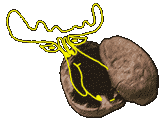Click on the logos on the left to come to the detailed section - more
additional sections on the left navigation bar as usual.
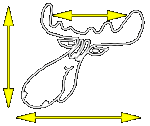
|
Main figures
- General facts
- Largest member of the deer family
- Bulls can reach a weight of up to 825kg (500-825kg)
- Shoulder height up to 250 cm (160-250 cm)
- Body length up to 350 cm (250-350 cm)
- Cows are in average 20% smaller and lighter than bulls
- Some details
- Very short tail (7-12 cm)
- Long-legded to step over obstacles - important to escape predators
- Hump at the shoulders - mainly muscles to hold the head
- Overhanging muzzle - the moose's trademark - perfect for feeding foliage
- also called "muffle" - maybe originating from the German "Muffel"
- Hair and skin hanging from the throat - called bell - serves mating season purposes
- Usually brownish-black, differences between species and season, European moose with white legs
- Long, air-filled coat hair - 10-25 cm long, changed April-June
- Life span of 27 years in captivity, 5-16 years in nature
- Spends time with 40% chewing cud, 40% eating and 20% sleep
- Senses
- 25 cm long, rotatable ears give excellent hearing sense
- Important nosing sense with special area for analyzing the cows readiness for mating
- Not so developped eyes, no red-green differentiation, but fairly good in darkness
|
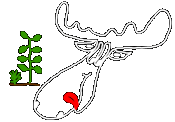
|
Food
- General facts
- Herbivore, i.e. plant eater
- Ruminant
- Can eat 15-50kg per day
- Feeding up to 10-12 hours a day
- "Browser", as they browse on twigs
- Food range
- Twig ends, leaf, roots, bark
- Preferably willows, but also white birch, balsam fir, trembling
aspen, black poplar, hazle, dogwood, maple
- Berries, apples, wildflowers, lichens, bushes, seeds, ferns,
mushrooms, tubers, sedges and grass
- Aquatic vegetation: Water lily, water shield, pondweed
- Some more details
- Can eat under-water due to their specialized muzzle, dive up to 6 m deep
- Needs minerals- salt licks, aquatic vegetation ...
- Have big liver to cope with toxic secondary plant compounds
- Bulls don't feed during mating time
|
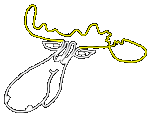
|
Antlers
- Main Facts
- The antlers - reserved to bulls - are up to 2,1m wide
- Up to 36kg heavy
- Up to 15 ends
- Size varies depending on habitat: European smaller and Northern
larger than Southern
- Growth
- During growth covered with a soft skin called velvet
- Shed every year in mid December
- New antlers start growing in April, maximum size August/September
- Fight, Sparring and mating
- Symbol off power - important for mating- the biggest antlers win
by visual show
- Seldomly in real fight, but if it occurs mostly uncritical
wounds occur
- Sparring is common between bulls before the real
"show-down"
|
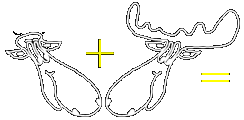
|
Mating and offspring
- Breeding season September/October, about 3-5 weeks
- Oligatory signals (e.g. urine on bell) and calls are used for
finding each other
- Mating "event" takes just 2-5 seconds
- Gestation period ~231 days, Birth in May/June
- 1-2 offspring, depending on the mother's age and food supply
- Calves eat huge amounts of rich mother milk, and very fast also
normal food
- Fully protected by very defensive mother
- Calves can run and swim within just a few days
- Calves weigh 120-200 kg already in autumn
- Time to offspring independance ~12 months
- Sexual maturity of male and femals ~ 2 years
|
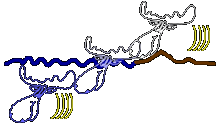
|
Mobility
- Excellent swimmers
- Swims even out on oceans for kilometers and can be attacked by
killer whales
- Can swim 10-20 km non-stop with up to 8 km/h
- Fast sprinters - up to 60 km/h
- No problems with rough surface with obstacles due to
their long legs
- Mastering obstacles heights of 60-90cm and snow up to 50 cm ->
Escape from predators !
- Usually walk slowly and calmy with 10 km/h
- Deep snow causes a real problem for them, as they cannot escape any
more
|
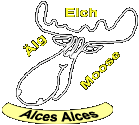
|
Name
- "Moose" comes from Algonquin Indians, "mos"
meaning twig-eaters
- Scientific name "Alces Alces"
|
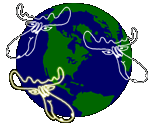
|
Habitat
- Forested areas with lakes or ponds
- Taiga, forest tundra, temperate forest and rainforest, boreal
and subarctic zones
- Zones with summer temperatures averaging 15 °C, not exceeding
27°C for long
- Approximate limits : 50th parallel to 67th parallel
- Home range of 10-250 km², depending on food supply
- Sub-species - classic science
- 9 different sub-species, from which one is extinct
- 4 sub-species in Eurasia, 4 in North-America
- Differentiation by discoverer and area
- New viewpoint today: Only two real sub-species:
- European/ West Siberian Moose (Alces Alces Alces)
- East Siberian / North American Moose (Alces Alces Americanus)
- Differentiation determined by environment
|

|
Enemies and Defense
- Enemies
- Prey to bears and wolves, seldomly lynx and wolverine
- Most threatened: Calves, only 2/3 survive their first year
(prey/environment)
- Wolve packs have good chance to win in deep snow and with
old/ill moose
- Defense
- Moose kick with front- and back-legs - leathal weapons
- Mainly try to escape- good chance due to long legs (predators
muts walk around obstacles)
- Moose can surround enemies, hide, and perfectly detect them
early enough
- Seek roads and rails during snow-time: Faster escape in low snow
- Environmental and parasite related threats
- Quite well suited for winter time, nevertheless hard time
- Winter ticks, meningeal worm and giant liver fluke often
cause death
|
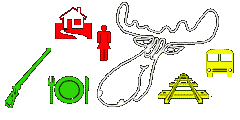
|
Human Interaction
- Hunting was and is common: Moose was nearly extinct in many areas
- Today moose population seems stabilized by nature preserve
- Road and rail traffic causes many moose deaths, as animals seek
trails in winter
- Domestication has been tried and works hardly well (diseases, food
requirements)
- Tries have been performed to use moose as mounts for riding in
armies
- Moose can get tame just as overdimensioned dogs
|
